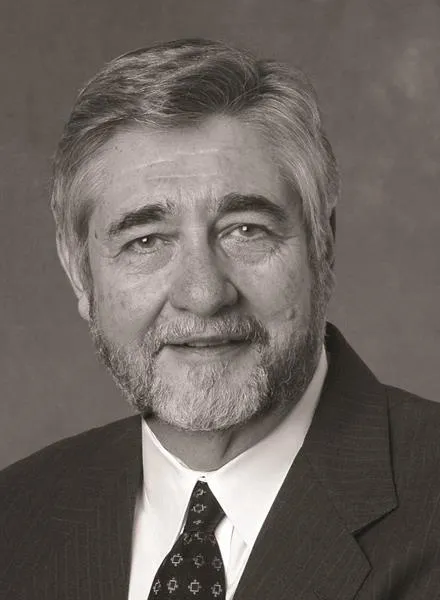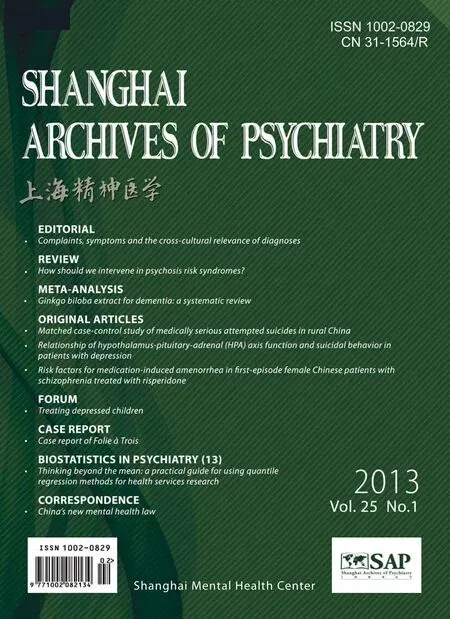Interventions for childhood depression
W. Edward CRAIGHEAD
? Forum ?Treating depressed children
Interventions for childhood depression
W. Edward CRAIGHEAD
Professor Du has provided a succinct summary of child and adolescent depression and its treatment with antidepressants.[1]There remains some controversy over the prevalence of depression in children and adolescents: Professor Du reports that 20% of individuals experience depression prior to the age of 18 while other epidemiological reports indicate that the rate is closer to 17%.[2-4]But this difference in rates is relatively small and may be due to methodological differences in the studies.As noted by Professor Du, suicidal ideation may increase in depressed children and adolescents who receive antidepressant treatment, but the rates of suicidal acts do not appear to increase. Overall, the beneficial effects of antidepressants, at least among depressed teenagers,appear to outweigh the risks.[5]
Fortunately, the incidence of depression is lower in children than in adolescents. Antidepressant use is of greatest concern in younger children: physicians are more willing to prescribe fluoxetine and other selective serotonin reuptake inhibitors (SSRIs) ‘off label’ for older adolescents with depression than they are for younger adolescents and children. For children,non-pharmacological psychosocial treatments such as Behavioral Activation[6,7](that may more easily be rendered age-appropriate than cognitive-behavioral therapy [CBT] or interpersonal psychotherapy [IPT]) are increasingly available and appear to be efficacious.
A new and important direction of research on childhood depression is the focus on preventing depression. Investigators throughout the world have implemented and evaluated specific interventions to prevent the occurrence of a first full-criteria episode of depression in children. Universal prevention programs are applied to entire populations of children (e.g., all the students in a school). Indicated prevention programs are targeted on selected ‘high-risk’ (or ‘a(chǎn)t-risk’) children– those with identifiable risk factors (e.g., cognitive distortions) or subsyndromal depressive symptoms.[8,9]
Universal programs have produced small effect sizes and their long-term results have, at best, been described as ‘mixed’.[10]Findings for Indicated prevention programs have been more encouraging: a CBT-based prevention program[11]effectively prevented depressive episodes among children of parents who suffered from depressive disorders; and a large U.S. prevention study based on CBT principles[12]prevented depression among at-risk children (unless there was a depressed mother in the child’s household). Similarly, a school-based CBT program[13]administered by current school staff to atrisk 14- and 15-year olds (the peak age for the onset of adolescent depression) in Iceland prevented an initial episode of depression and the preventive effects were maintained over a 1-year follow-up period. This program is currently being evaluated in a prevention program in schools in Portugal.
These findings about the prevention of childhood depression are important for a number of reasons. First,the prevention of an initial episode of depression among children at risk prevents the personal, social and societal effects of a Major Depressive Episode. Second, data show clearly that once a first episode of depression has occurred, the risk of a second episode is greatly increased,so the prevention (or at least delay) of an initial episode may forestall the development of a chronic relapsing condition.[3]The delay in onset of the initial episode also allows more time for the development of academic and social skills and more time for the maturation of neural pathways of resilience among at-risk youth. And since antidepressant use is more acceptable in older than younger adolescents, delay of the initial episode of depression will have the result that a wider range of alternative treatments are available if and when a Major Depressive Episode occurs.
Acknowledgment
The writing of this paper was supported in part by gifts from the Brock Family Fund and from the Realan Foundation to W. E. Craighead.
Conflict of interest
Professor Craighead is an officer of Hugarheil Incorporated, an Icelandic Company dedicated to the dissemination of programs for prevention of depression and he receives book royalties from John Wiley & Sons.
1. Du YS. Should antidepressants be used to treat childhood depression? Shanghai Archives of Psychiatry 2013; 25(1): 48-49.
2. Fergusson DM, Horwood J, Ridder EM, Beautrais AL. Subthreshold depression in adolescence and mental health outcomes in adulthood. Arch Gen Psychiatry 2005; 62: 66–72.
3. Rohde P, Lewinsohn PM, Klein DN, Seeley JR, Gau JM. Key characteristics of major depressive disorder occurring in childhood, adolescence, emerging adulthood, and adulthood.Clinical Psychological Science 2012; 1: 1-12.
4. Twenge JM, Gentile B, DeWall C, Ma D, Lacefield K, Schurtz DR. Birth cohort increases in psychopathology among young Americans, 1938–2007: A cross-temporal meta-analysis of the MMPI. Clin Psychol Rev 2010; 30: 145-154.
5. Bridge JA, Iyengar S, Salary CB, Barbe RP, Birmaher B, Pincus HA,et al. Clinical response and risk for reported suicidal ideation and suicide attempts in pediatric antidepressant treatment: a metaanalysis of randomized controlled trials. JAMA 2007: 297: 1683-1696.
6. Dimidjian S, Hollon SD, Dobson KS, Schmaling KD, Kohlenberg RJ, Addis ME, et al. Randomized trial of behavioral activation,cognitive therapy, and antidepressant medication in the acute treatment of adults with major depression. J Consult Clin Psychol 2006; 74: 658-670.
7. Ritschel LA, Ramirez CL, Jones M, Craighead WE. Behavioral Activation for depressed teens: results of a pilot study. Cognitive and Behavioral Practice 2011; 18: 281-299.
8. Ge X, Conger RD, Elder GHJ. Pubertal transition, stressful life events, and the emergence of gender differences in adolescent depressive symptoms. Dev Psychopathol 2001; 37: 404-417.
9. Verstraeten K, Vasey MW, Raes F, Bijttebier P. Temperament and risk for depressive symptoms in adolescence: Mediation by rumination and moderation by effortful control. Journal of Abnormal Child Psychology 2009; 37: 349-361.
10. Horowitz JL, Garber J. The prevention of depressive symptoms in children and adolescents: a meta-analytic review. J Consult Clin Psychol 2006; 74: 401-415.
11. Clarke GN, Hornbrook M, Lynch F, Plen M, Gale J, Beardslee W,et al. A randomized trial of a group cognitive intervention for preventing depression in adolescent offspring of depressed parents. Arch Gen Psychiatry 2001; 58: 1127-1134.
12. Garber J, Clarke GN, Weersing VR, Beardslee WR, Brent DA,Gladstone TRG, et al. Prevention of depression in at-risk adolescents. JAMA 2009; 301: 2215-2224.
13. Arnarson EO, Craighead WE. Prevention of depression among Icelandic adolescents: A 12-month follow-up. Beh Res Ther 2011;49, 170-174.
10.3969/j.issn.1002-0829.2013.01.009
Department of Psychiatry and Behavioral Sciences and Department of Psychology, Emory University, Atlanta, GA, United States correspondence: ecraigh@emory.edu

Professor W. Edward Craighead, Ph.D., ABPP, holds the J. Rex Fuqua Endowed Chair and is Professor and Vice-Chair of Child, Adolescent, and Young Adult Programs in the Emory University Department of Psychiatry and Behavioral Sciences. He is also a Professor of Psychology at Emory University. He has written/edited 11 books,including a widely used graduate textbook, Psychopathology. He has published over 175 papers primarily focusing on the psychosocial aspects, prevention, and treatment of Major Depression and Bipolar Disorders. He is Editor of Clinical Psychology: Science and Practice, and previously was Editor of Behavior Therapy.He is a Past-President of the Association of Behavioral and Cognitive Therapies and of the Clinical Division of the American Psychological Association.
- 上海精神醫(yī)學(xué)的其它文章
- SHANGHAI ARCHIVES OF PSYCHIATRY INSTRUCTIONS TO AUTHORS
- Detailed operational regulations are needed to implement the mental health law
- Thinking beyond the mean: a practical guide for using quantile regression methods for health services research
- Case report of Folie à Trois
- Should antidepressants be used to treat childhood depression?
- Risk factors for medication-induced amenorrhea in first-episode female Chinese patients with schizophrenia treated with risperidone

